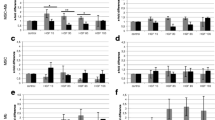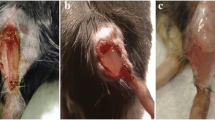Abstract
Fibroblast growth factor 2 (FGF2) protein plays important roles in wound healing and tissue regeneration. Collagen is clinically used for wound care applications. We investigated the potential value of FGF2-functionalized collagen matrices for skeletal muscle tissue engineering. When C2C12 cells were treated with FGF2, cell adhesion increased after 3 and 5 days compared to the control (P < 0.05). Wound healing activity of FGF2 was slightly higher than the control through cell migration. Cell proliferation activity of FGF2-functionalized collagen matrices on C2C12 cells also increased. Taken together, FGF2 stimulated C2C12 myoblast growth by promoting cell adhesion, proliferation and wound healing activity after injury. The potential effect of FGF2-functionalized collagen matrices was also observed. Thus FGF2 stimulates skeletal muscle development and regeneration, thereby leading to potential utility for skeletal muscle tissue engineering.





Similar content being viewed by others
References
Anderson JE, Mitchell CM, Mcgeachie JK, Grounds MD (1995) The time course of basic fibroblast growth factor expression in crush-injured skeletal muscle of SJL/J and BALB/c mice. Exp Cell Res 216:325–334
Bhang SH, Sun AY, Yang HS, Rhim T, Kim DI, Kim BS (2011) Skin regeneration with fibroblast growth factor 2 released from heparin-conjugated fibrin. Biotechnol Lett 33:845–851
Di Lullo GA, Sweeney SM, Körkkö J, Ala-Kokko L, San Antonio JD (2002) Mapping the ligand-binding sites and disease-associated mutations on the most abundant protein in the human, type I collagen. J Biol Chem 277:4223–4231
Fridovich I (1978) The biology of oxygen radicals. Science 201:875–880
Fu X, Cuevas P, Gimenez-Gallego G, Martinez-Murillo R, Tian H, Sheng Z (1996) Ischemia and reperfusion reduce the endogenous basic fibroblast growth factor in rat skeletal muscles: an immunohisto-chemical study. Wound Repair Regen 4:381–385
Fu X, Yang Y, Li X, Sun T, Wang Y, Sheng Z (1998) Ischemia and reperfusion impair the gene expression of endogenous basic fibroblast growth factor (bFGF) in rat skeletal muscles. J Surg Res 80:88–93
Goldspink G (1999) Changes in muscle mass and phenotype and the expression of autocrine and systemic growth factors by muscle in response to stretch and overload. J Anat 194:323–334
Gu C, Zheng R, Yang Z, Wen A, Wu H, Zhang H, Yi D (2009) Novel glycidyl methacrylated dextran/gelatin nanoparticles loaded with basic fibroblast growth factor: formulation and characteristics. Drug Dev Ind Pharm 35:1419–1429
Harding KG, Morris HL, Patel GK (2002) Science, medicine and the future: healing chronic wounds. BMJ 324:160–163
Jang JH, Chung CP (2004) Engineering and expression of a recombinant fusion protein possessing fibroblast growth factor-2 and fibronectin fragment. Biotechnol Lett 26:1837–1840
Jang JH, Ku Y, Chung CP, Heo SJ (2002) Enhanced fibronectin-mediated cell adhesion of human osteoblast by fibroblast growth factor, FGF-2. Biotechnol Lett 24:1659–1663
Jeon E, Jang JH (2009) Protein engineering of a fibroblast growth factor 2 protein for targeting to bone mineral hydroxyapatite. Protein Pept Lett 16:664–667
Kellogg EW 3rd, Fridovich I (1975) Superoxide, hydrogen peroxide, and singlet oxygen in lipid peroxidation by a xanthine oxidase system. J Biol Chem 250:8812–8817
Kwan MD, Sellmyer MA, Quarto N, Ho AM, Wandless TJ, Longaker MT (2011) Chemical control of FGF-2 release for promoting calvarial healing with adipose stem cells. J Biol Chem 286:11307–11313
Lefaucheur JP, Sebille A (1995a) Basic fibroblast growth factor promotes in vivo muscle regeneration in murine muscular dystrophy. Neurosci Lett 202:121–124
Lefaucheur JP, Sebille A (1995b) Muscle regeneration following injury can be modified in vivo by immune neutralization of basic fibroblast growth factor, transforming growth factor β1 or insulin-like growth factor I. J Neuroimmunol 57:85–91
Madry H, Orth P, Kaul G, Zurakowski D, Menger MD, Kohn D, Cucchiarini M (2010) Acceleration of articular cartilage repair by combined gene transfer of human insulin-like growth factor I and fibroblast growth factor-2 in vivo. Arch Orthop Trauma Surg 130:1311–1322
Manferdini C, Guarino V, Zini N, Raucci MG, Ferrari A, Grassi F, Gabusi E, Squarzoni S, Facchini A, Ambrosio L, Lisignoli G (2010) Mineralization behavior with mesenchymal stromal cells in a biomimetic hyaluronic acid-based scaffold. Biomaterials 31:3986–3996
Nambu M, Ishihara M, Kishimoto S, Yanagibayashi S, Yamamoto N, Azuma R, Kanatani Y, Kiyosawa T, Mizuno H (2011) Stimulatory effect of autologous adipose tissue-derived stromal cells in an atelocollagen matrix on wound healing in diabetic db/db mice. J Tissue Eng 2011:158105
Nishikage S, Koyama H, Miyata T, Ishii S, Hamada H, Shigematsu H (2004) In vivo electroporation enhances plasmid-based gene transfer of basic fibroblast growth factor for the treatment of ischemic limb. J Surg Res 120:37–46
Nugent MA, Newman MJ (1989) Inhibition of normal rat kidney cell growth by transforming growth factor-beta is mediated by collagen. J Biol Chem 264:18060–18067
Paralkar VM, Vukicevic S, Reddi AH (1991) Transforming growth factor beta type 1 binds to collagen IV of basement membrane matrix: implications for development. Dev Biol 143:303–308
Parks DA, Bulkley GB, Granger DN (1983) Role of oxygen free radical in shock, ischemia and organ preservation. Surgery 94:428–432
Schmal H, Mehlhorn AT, Fehrenbach M, Müller CA, Finkenzeller G, Südkamp NP (2006) Regulative mechanisms of chondrocyte adhesion. Tissue Eng 12:741–750
Schreier T, Degen E, Baschong W (1993) Fibroblast migration and proliferation during in vitro wound healing. Res Exp Med (Berl) 193:195–205
Schuppan D, Schmid M, Somasundaram R, Ackermann R, Ruehl M, Nakamura T, Riecken EO (1998) Collagens in the liver extracellular matrix bind hepatocyte growth factor. Gastroenterology 114:139–152
Slater TF (1984) Free radical mechanisms in tissue injury. Biochem J 222:1–15
Somasundaram R, Schuppan D (1996) Type I, II, III, IV, V, and VI collagens serve as extracellular ligands for the isoforms of platelet-derived growth factor (AA, BB, and AB). J Biol Chem 271:26884–26891
Still J, Glat P, Silverstein P, Griswold J, Mozingo D (2003) The use of a collagen sponge/living cell composite material to treat donor sites in burn patients. Burns 29:837–841
Wright-Carpenter T, Klein P, Schäferhoff P, Appell HJ, Mir LM, Wehling P (2004) Treatment of muscle injuries by local administration of autologous conditioned serum: a pilot study on sportsmen with muscle strains. Int J Sports Med 25:588–593
Yang Y, Xia T, Zhi W, Wei L, Weng J, Zhang C, Li X (2011) Promotion of skin regeneration in diabetic rats by electrospun core-sheath fibers loaded with basic fibroblast growth factor. Biomaterials 32:4243–4254
Yun YR, Won JE, Jeon E, Lee S, Kang W, Jo H, Jang JH, Shin US, Kim HW (2010) Fibroblast growth factors: biology, function, and application for tissue regeneration. J Tissue Eng 2010:218142
Acknowledgement
This work was supported by Priority Research Centers Program (grant#: 2009-0093829) and WCU (World Class University) program (grant#: R31-10069) through the National Research Foundation (NRF) funded by the Ministry of Education, Science and Technology, and by the Korea Research Foundation Grant funded by the Korean Government (MOEHRD) (KRF-2007-314-E00183).
Author information
Authors and Affiliations
Corresponding author
Additional information
Ye-Rang Yun, Sujin Lee, and Eunyi Jeon contributed equally to this work.
Rights and permissions
About this article
Cite this article
Yun, YR., Lee, S., Jeon, E. et al. Fibroblast growth factor 2-functionalized collagen matrices for skeletal muscle tissue engineering. Biotechnol Lett 34, 771–778 (2012). https://doi.org/10.1007/s10529-011-0812-4
Received:
Accepted:
Published:
Issue Date:
DOI: https://doi.org/10.1007/s10529-011-0812-4




